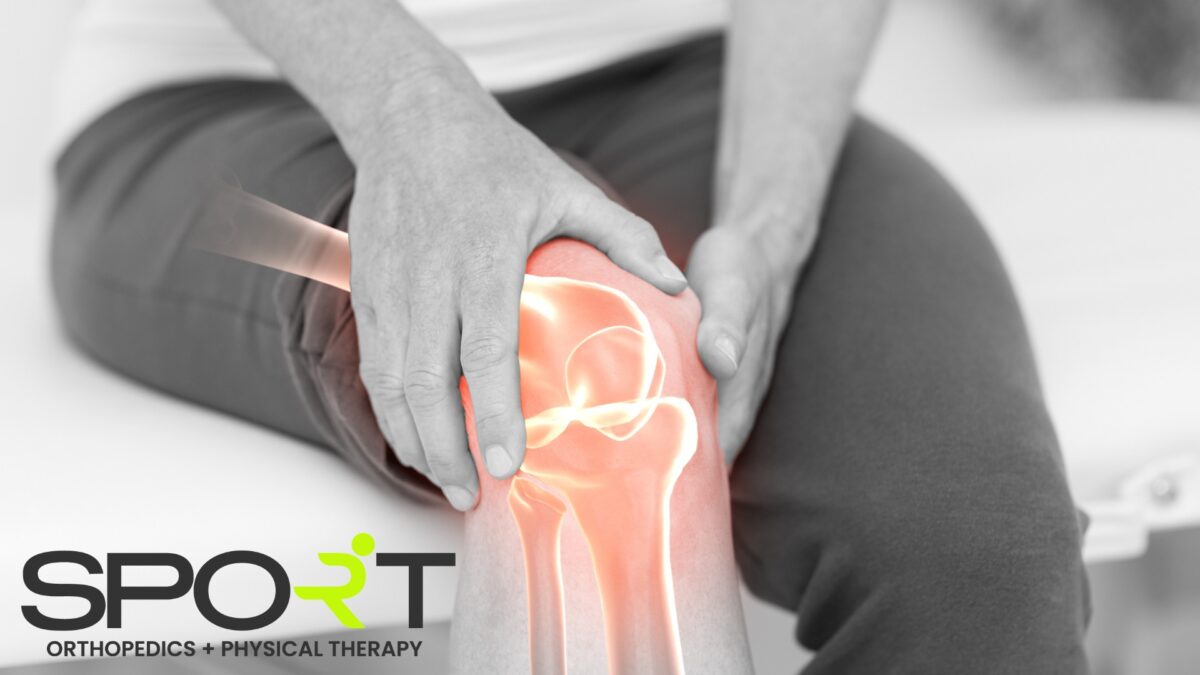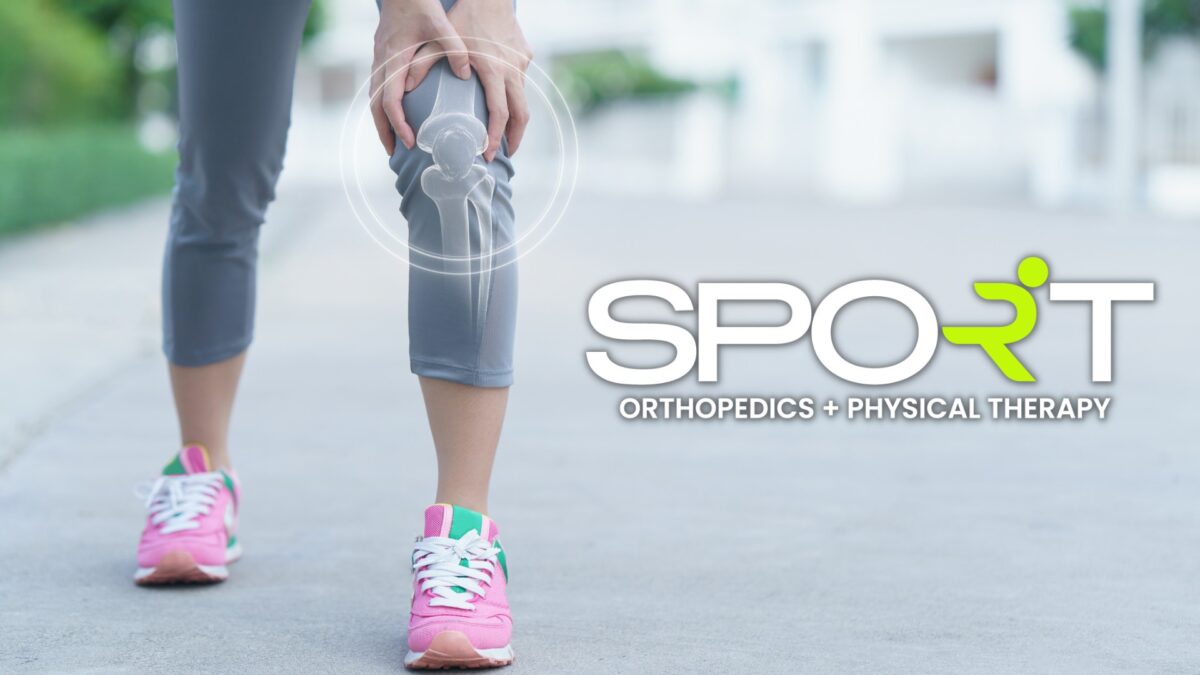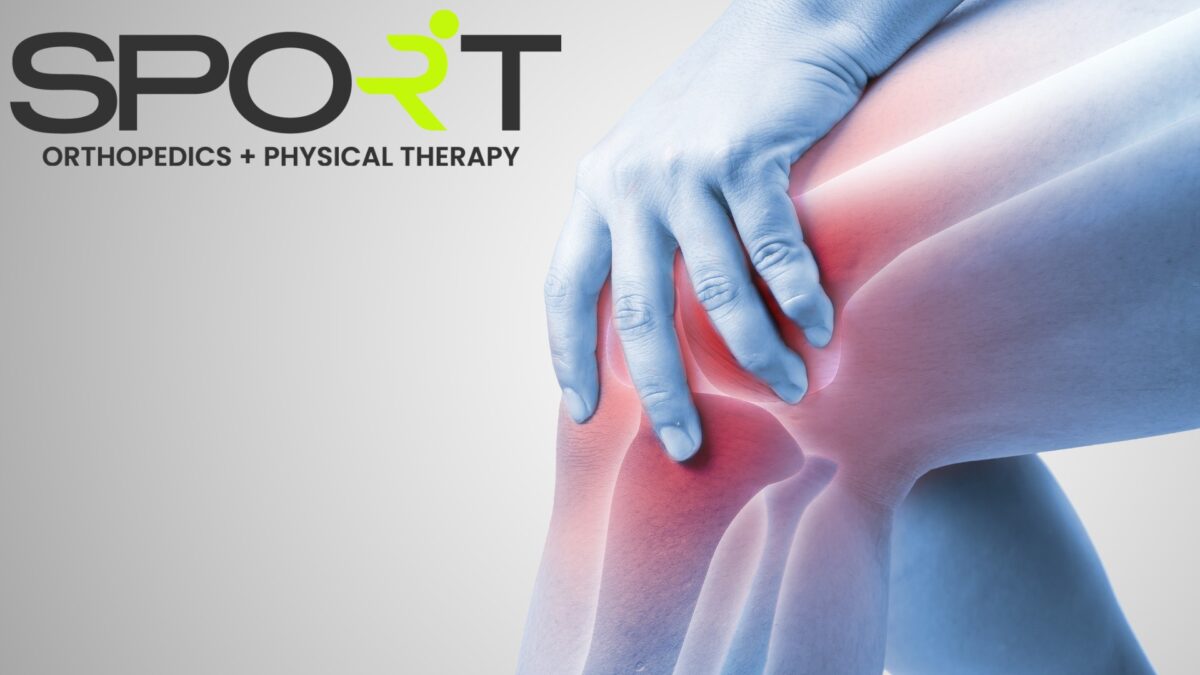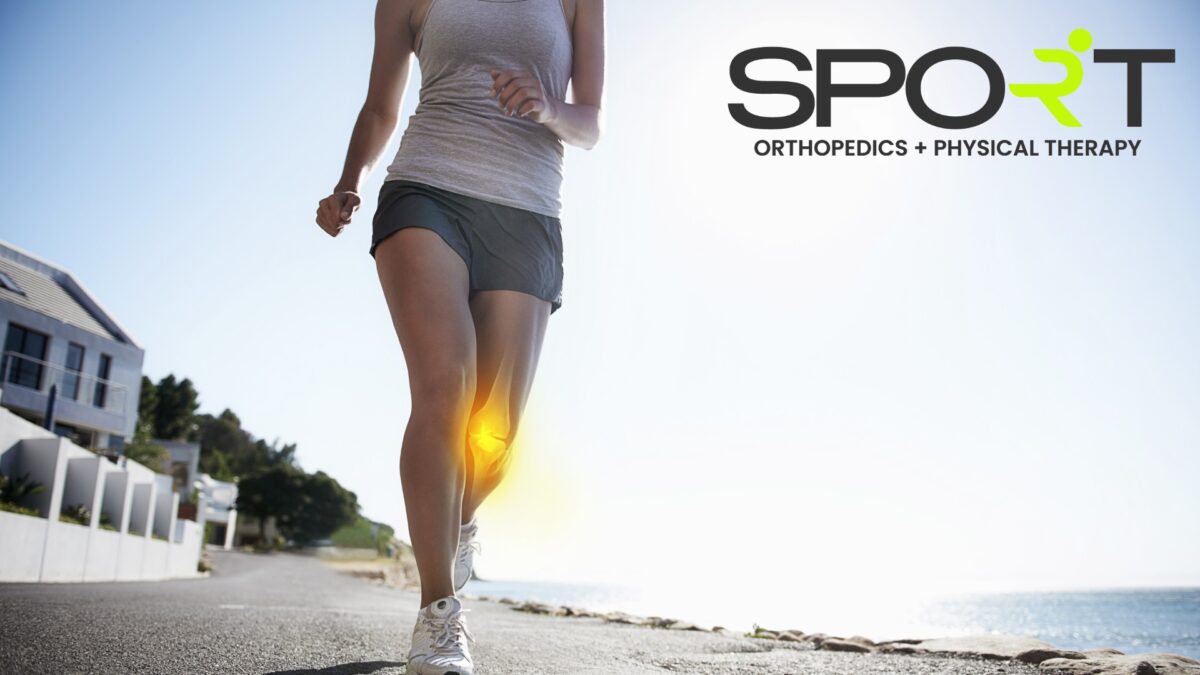
Our knee pain location chart lists all the painful areas of the knees and can help you and your doctor pinpoint the exact area that is causing the knee pain. The knee is a synovial hinge joint supplied with synovial fluid to lubricate movement and move the knee back and forth like a hinge. It is a complex body part including bone, cartilage, muscle, tendon, ligament, synovial fluid, and nerves. Depending on where you're experiencing the pain in your knee is determined by the area it's affecting. For example, if you're suffering from pain on either side of your knee cap, it could be arthritis or a meniscus or ligament tear.
If you're struggling with persistent knee pain, it may be time to see a Texas sports medicine specialist. Contact the team at SPORT Orthopedics + Physical Therapy as soon as possible for a proper evaluation and diagnosis of your pain. Once we know the source, we'll develop a specialized treatment plan that meets your needs. We also offer orthopedic urgent care in Dallas for those who need quick, effective treatment. To schedule an appointment with one of our providers, please call our clinic at 469-200-2832 today.

The front of the knee is the location of the quadriceps tendon that attaches the four large muscles of the front thigh to the knee cap. An injury to the quadriceps tendon is the most common cause of pain in the anterior area of the knee (the front of the knee).
Front knee pain is most common in people who are overweight, runners and people that exercise regularly, teenagers and young adults, and people who have a dislocation, fracture, or other injuries to the kneecap. Anterior knee pain is usually caused when the knee cap (patella) rubs against the lower part of the thigh bone. This can be caused by various factors, including poor kneecap alignment, too much activity that stresses the kneecap (like running), flat feet, or unbalanced core muscles.
An ACL tear or sprain is an injury to the anterior cruciate ligament. The ACL is one of the strong bands of tissue that connect your thigh bone(femur) to your shinbone (tibia). ACL injuries usually affect football, soccer, basketball, or downhill skiing athletes. These sports involve sudden stops or changes in direction, jumping, and landing.
Quadriceps tendonitis is irritation, strain, or injury to the quadriceps tendon attached to the kneecap. It's caused by overuse or alignment problems in the quadriceps.
A plica is the fold in the thin synovial membrane that protects the knee joint. Most people have four folds in each knee, but they can often be absorbed in fetal development. When the plica becomes inflamed, it causes pain, swelling, and instability in the knee. Plica syndrome can often be due to repetitive knee movements like trauma or twisting.
As stated above, the knee is a synovial hinge joint lined with synovial membrane. When this membrane becomes inflamed, it's called synovitis. Overuse or trauma results in bleeding in the joint, causing synovitis. If not caught early, the membrane will thicken with blood and become more painful. Arthritis and gout are associated with synovitis.

Pain at the back of the knee, also known as the posterior area, can be caused by several different conditions. The most common causes of back knee pain are problems related to the muscles, tendons, or ligaments. Other causes of posterior knee pain may be related to synovial fluid or blood vessels. Hamstring tendonitis is the most common posterior injury caused by overuse resulting in knee pain.
A problem with the cartilage and knee cap usually causes pain behind the knee cap. One common posterior knee issue is referred to as Runners Knee, where the way the knee cap glides causes friction behind the knee cap.
Hamstring tears are caused by overuse of the hamstring muscles, the three muscles that run along the back of the thigh. These tears are usually caused by strenuous exercise or straining or pulling the hamstring muscle. When there is a tear in the hamstring, the tendon is pulled away from the hamstring muscle or bone.
Hamstring tendonitis occurs when you overuse or over stretch the hamstring tendons causing inflammation at the back of the knee and thigh.
The posterior cruciate ligament, or PCL, is one of the four major ligaments of the knee joint. PCL tears or sprains often occur when the knee is bent and directly hit. Athletes often suffer from posterior cruciate ligament injuries. They are broken into three categories: Grade I is minimal damage, Grade II is moderate damage with partial tearing, and Grade III is a complete ligament tear.
A torn meniscus usually results from twisting or rotating your knee with force. It's the most common type of knee injury. The tear can happen in either the posterior horn of the medial or lateral meniscus and can lead to severe pain behind the knee.
A Bakers' cyst will form when an excessive amount of synovial fluid accumulates in an inflamed bursa of the popliteal fossa. Also known as a popliteal cyst, these fluid-filled cysts form at the back of the knee and cause stiffness and discomfort. They are often the result of a meniscus tear or osteoarthritis.

Pain on the outside of the knee (the lateral area) is usually caused by injury, inflammation, or arthritis. Lateral knee injuries are common in long-distance runners. When the tissue that runs down the outside of the thigh and attaches to the front of the tibia (shin bone) becomes inflamed, it causes lateral area pain.
A sports injury, overuse of the knee, or aging can cause outer knee pain. Iliotibial Band Syndrome is the most common knee injury affecting the outside of the knee. Below, we outline the most common conditions affecting the outside of the knee.
Iliotibial Band Syndrome (IT Band Syndrome) is the inflammation and irritation of the thick fibrous iliotibial band that runs from the pelvis to the tibia along the outside of the leg. The IT Band can become swollen from rubbing against your hip or knee bones.
Lateral collateral ligament injuries are caused by pressure or injury that pushes the knee joint from the inside creating stress on the outside joint. Injuries to the LCL can be a strain, sprain, or tear of any part of the ligament. The lateral collateral ligament keeps the knee joint stable.
A lateral meniscus tear affects the semicircular cartilage outside of the knee joint. They can develop gradually over time or suddenly due to a twisting or traumatic injury.
Hamstring tendonitis is the inflammation of the hamstring tendon that attaches the hamstring muscles to the back of the knee.
Often the result of a traumatic fall or other injuries, a tibia fracture occurs when an injury pushes the lower end of the thigh bone (femur) into the soft bone of the tibial plateau. A fracture can also cause a break in several pieces.
Knee osteoarthritis occurs when arthritis develops in the lateral area. When the flexible cushion at the end of bones wears down, extra fluid may be produced, and bony osteophytes form.

The deterioration of cartilage usually causes the inside of the knee or medial area pain. This pain can also be caused by a sports injury or other type of trauma to the medial area of the knee. Most medial knee injuries will be similar to the lateral side.
Injuries that cause pain inside the knee can include a blow to the outside of the knee that pushes your knee inward, activities involving twisting or pivoting your knees, and activities that rely heavily on the knees, like cycling.
When the meniscus on the inner side of your knee is torn, it can cause pain and inflammation. See also lateral meniscus tear.
A medial collateral ligament injury is a tear or sprain to the ligament that runs down the inside of your knee. This can be caused by a direct blow to the knee, twisting the knee, or overuse. Damage to the medial collateral ligament can be a stretch or tear in the ligament.
When the cartilage of the medial femorotibial compartment wears down, the extra synovial fluid can create bony osteophytes. This causes the bones in your joints to rub together.
Avascular necrosis, also known as osteonecrosis of the knee, is a painful condition that occurs when the bone tissue dies due to a lack of blood supply, causing the bone to collapse. It can often be attributed to heavy alcohol or long-term steroid medication use.

Pain at the knee cap is caused by overuse, injury, tendonitis, and runner's knee or patellofemoral pain syndrome.
Women are more susceptible to knee cap pain due to their size, and the knee cap does not often align correctly. Anyone who performs sports that stress the knees, like basketball, soccer, or weightlifting, can also be susceptible to knee cap pain.
Patellofemoral arthritis is caused when the knee cap does not run smoothly along the groove of the lower end of the thigh bone. This causes the cartilage to wear away and bones to rub against one another, causing knee pain.
Patellofemoral pain syndrome, runner's knee, can develop when a person starts a strenuous activity like exercising. It's characterized by dull pain at the front of the knee and around the knee cap. Runner's knee is caused by overuse or misalignment of the kneecap.
The kneecap can become dislocated from twisting or trauma, causing it to move out of the track in the thigh bone. The dislocated patella creates severe knee pain and swelling at the front of the knee.
Extra stress or over-stretching the patellar tendon at the front of the knee can cause patellar tendonitis.
Bursae are thin, fluid-filled sacs between the bone and soft tissue. When one of the bursae at the front of the knee becomes inflamed, it causes swelling on the knee and tenderness. This is known as bursitis.
The deterioration of the cartilage between the knee joints causes knee osteoarthritis. When the cartilage wears down, there is no longer any cushion between the bones resulting in knee pain and stiffness.
Inflammatory joint disease, also called inflammatory arthritis, includes various forms of arthritis that all involve the inflammation of the joints and other tissues, causing knee pain. Often they are autoimmune diseases that cause the body's immune system to turn on itself, damaging its tissue. Inflammatory joint disease can result in swelling, pain, stiffness, and reduced joint function.
So, how do I know if my knee injury is serious? Knee joint pain that results in your inability to put weight on your leg, joint deformity, sudden swelling, or popping noises is a cause for concern. If your knee pain continues after days of monitoring, consider medical attention.
If your knee pain interferes with your everyday activities and sleep, you'll want to seek medical attention before the pain worsens. Knee pain is caused by trauma and can accompanied by redness, swelling, severe pain, and fever. Call your doctor immediately if you experience any of those symptoms. You'll also want to consider medical attention if your knee pain worsens.
If you're suffering from knee pain affecting your everyday life, let SPORT Orthopedics + Physical Therapy help you get back on your feet. Don't suffer from knee pain any longer! Our board-certified orthopedic specialists will evaluate your knee pain and work with you on a personalized treatment plan so that you can get back to enjoying life. Call SPORT at 469-200-2832 or schedule an online appointment to start your recovery journey.









*We accept most all insurance plans, if you do not see your plan listed above or have any questions, please contact our office.

SPORT Orthopedics + Physical
Therapy – Dallas, TX
Services:
• Clinic • Orthopedic • Urgent Care
• Physical Therapy
18152 Preston Road
Suite I-2
Dallas, TX 75252
Phone: (469) 200-2832
Fax: (469) 269-1074
SPORT Orthopedics + Physical Therapy – Frisco, TX
Services:
• Clinic • Orthopedic • Urgent Care
• Physical Therapy
9255 Dallas Parkway
Suite I20
Frisco, TX 75033
Phone: (469) 200-2832
Fax: (469) 269-1074
SPORT Orthopedics + Physical
Therapy – Wylie, TX
Services:
• Clinic • Orthopedic • Urgent Care
• Physical Therapy
3400 FM 544
Suite 650
Wylie, TX 75098
Phone: (469) 200-2832
Fax: (469) 269-1074
SPORT Physical
Therapy – Prosper, TX
Services:
• Physical Therapy
790 N Preston Rd
Suite 60
Prosper, TX 75078
Phone: (469) 850-0201
Fax: (469) 269-1074
SPORT Orthopedics – Mesquite, TX
Services:
• Clinic
• Orthopedic
• Urgent Care
1102 North Galloway Ave
Mesquite, TX 75149
Phone: (469) 200-2832
Fax: (469) 269-1074